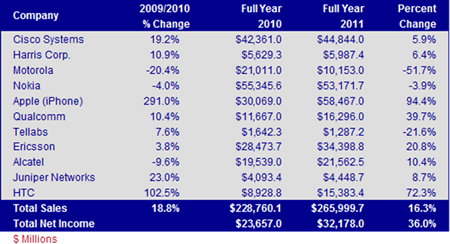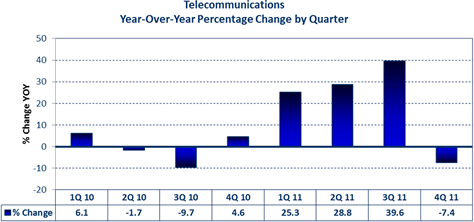The Telecom/Datacom Market for Cable Assemblies, Mobile Devices Drive Market
 The telecom industry continues to experience better growth than other market sectors due, in good part, to the world’s insatiable appetite for mobile subscriber technology, particularly smartphones.
The telecom industry continues to experience better growth than other market sectors due, in good part, to the world’s insatiable appetite for mobile subscriber technology, particularly smartphones.
According to Gartner, smartphone manufacturers shipped 472 million of the devices in 2011 and they now compose 31% of the cellphone market. This is a 58% increase from 2010, when the industry shipped 297 million smartphones. J.P. Morgan predicts that 657 million smartphone will be sold worldwide in 2012. On the infrastructure side of telecommunications, each smartphone has the capability to consume enormous amounts of data. The average Internet user accesses more than 10 Gigabits of information per month, much of which is downloaded on mobile devices. This requires an infrastructure system with the bandwidth and speed to handle the volume, and has driven service providers, such as Verizon, to make substantial investments in switching and backhaul equipment.
Bishop tracks 13 market sectors for electronic interconnects. Of the 13 market sectors, telecom was the second-fastest growing manufacturing segment in 2011. Profitability was up 36% year-over-year and sales growth was slightly below 2010.
The telecom equipment sector recorded a sales increase of 18.8% in 2010. The companies that Bishop tracks in this market segment grew an average of 16.3% in 2011 over 2010, and the combined net income grew to $32.2 billion, a 12.1% net income.
Motorola is the biggest loser in this market sector, with a sales decline of -51.7% in 2011, which is due to their struggle to be cost-competitive and develop market-accepted products. On the plus side, Motorola’s profitability improved 82.9% year-over-year. Also on the subscriber side, Nokia, the largest cellphone manufacturer in the world, had a sales decline of -3.9% and a -44.8% plunge in profitability. For infrastructure equipment, Tellabs experienced a tough year, as sales declined on their legacy equipment and a major customer, AT&T, choose Cisco’s IP switch product for their 4G LTE networks. Tellabs sales declined -21.6% year-over-year and net income fell to a negative $200 million.
Apple was the biggest gainer in 2011, with iPhone sales growth of 94.4% and net income up 119%. HTC also had a good year in smartphone sales, growing 72.3% year-over-year with a net income growth of 60%. Cisco, Harris, Alcatel, and Juniper Networks all had respectable year-over-year growth in sales for their infrastructure equipment, growing 6% to 10% year-over-year in a difficult economic environment.
Telecom/Datacom Equipment Sector – Sales and Net Income

As can be seen in the following chart, year-over-year sales had been climbing each quarter for the telecom sector since the fourth quarter of 2010, or four consecutive quarters of growth before dropping -7.4% in the fourth quarter of 2011. Sequentially, fourth quarter 2011 sales declined -11.1% from the third quarter of 2011.
 |
|
Impact on the Cable Assembly Industry
Bishop projects the worldwide market for telecom/datacom cable assemblies to grow 3.8% for 2012. What happens in 2012 and beyond is dependent on social, economic, and political factors worldwide. Some observations:
-
Although Europe narrowly averted a recession in the fourth quarter of 2011, their economies have stagnated. Elections in Greece and France have destabilized the delicate economic balance of the euro zone. If Greece leaves the euro zone and/or France does not continue to support restrained sovereign spending, the euro zone could come apart and a full-fledged recession would ensue. Year-to-date, the interconnect industry is down double digits in Europe. This would only be expected to get worse.
-
High demand for smartphones in China and Asia Pacific will drive growth of this market beyond the regional GDP growth expectations, although the GDP growth in the region is cooling off from the prior couple of years.
-
Smartphone sales continued to grow, even during the last recession. Our appetite for these products seems to defy the economic malaise.
-
Over 80% of all cellphones are now produced in China and Asia Pacific, so the growth of the smartphone market will primarily benefit that region.
-
The infrastructure products are still manufactured worldwide. Some of the more standardized technologies, however, like IP switches (as these infrastructure systems gravitate to IP architecture), will start being manufactured more in Asia.
Bishop & Associates projects the worldwide market for telecom cable assemblies to grow to $18.2 billion in 2012. The majority of the growth will be in China, Asia Pacific, and ROW, where the expansion will be between 5% to 8%. North America and Europe are anticipated to contract 1% to 4% in 2012.
- The Outlook for the Cable Assembly Industry in 2021 and Beyond - May 18, 2021
- A Data-Hungry World is Driving Demand for Wireless Connections - January 26, 2021
- Innovation and Expansion Drives Growth of Global Cable Assembly Market - May 7, 2019

